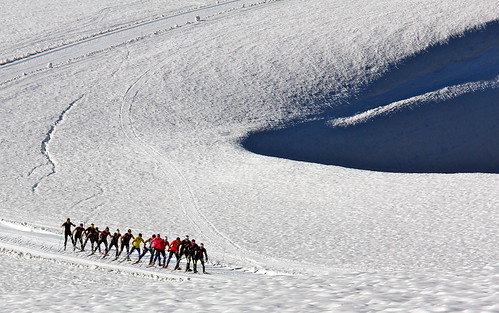
America’s elite, Olympic-bound Nordic skiers have a high-altitude secret they hope will give them an edge in Sochi, Russia, during the 2014 Winter Olympics in late February.
Team members take a 10-minute helicopter ride from sea level up to Eagle Glacier on Alaska’s Chugach National Forest, the most northern national forest in the U.S. The environment there mimics what they expect to find in Sochi.
The glacier, 5,500 feet above Girdwood, Alaska, is home to the Thomas Training Center operated under permit by the Alaska Pacific University Nordic Ski Center. The ski center was established in the late 1990s as a model for creating international success in American Nordic skiing.
“Right now we have three ladies who have skied in the top 10,” said Erik Flora, center director and head coach. “We have Kikkan Randall, who is the overall sprint World Cup leader last year, and World Champion Holly Brooks, who is fifth in the World Cup, and Sadie Bjornsen, who is also in the top 10 in the World Cup. Right now we are one of the only clubs with three ladies in the top 10 in the World Cup. And a lot of that is due to skiing up here.”
The glacier presents variable conditions like those that skiers are likely to encounter when they race overseas in the world championships or the Olympics. Whether it’s soft, slushy snow or hard snow, it all helps to build technique and fitness. The regular presence of fog and clouds require skiers to sharpen all of their senses.
Flora and his team have used those conditions to their advantage, re-creating the trails and experience racers will confront in Sochi.
Noah Hoffman, a member of the men’s team who hopes to compete in Sochi, described the trails in Russia as some of the most difficult he’s ever skied in the world, with the longest climb of any race course he’s ever seen. Flora created a similar layout on the glacier.
“To be able to practice a climb of that length and that sustained effort is really important,” said Hoffman. “Sochi also has some rolling terrain with moderate steepness of hills, and on another section of the course out here [on Eagle] Erik was able to mimic that and get us a good feel for the upper part of the Sochi trail.”
From the moment they exit the helicopter, walk off the rocks and onto the glacier, skiers recognize what a special place it is. Globally, there are four or five major summer skiing snowfields or glaciers that cross country skiers practice on in the summer. Eagle is unique in that you can stay in a warm dormitory right at the glacier’s edge.
“There’s no other place in the world that’s like Eagle Glacier,” said Holly Brooks, a member of the U.S. Women’s ski team. “This is the only place you can sleep right next to a glacier and train twice a day. You wake up in the morning and walk out on snow.”
